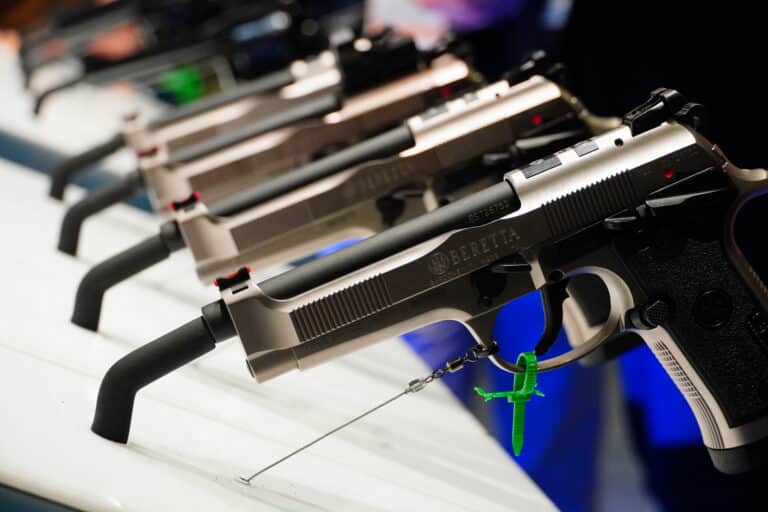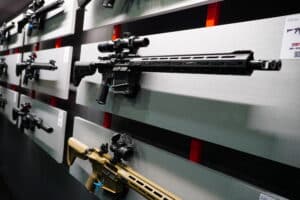On Friday, in US v. Heriberto Carbajal-Flores, a federal judge said 18 U.S.C. § 922(g)(5)’s ban on illegal immigrants owning guns violates the Second Amendment. That decision likely misapplies the Supreme Court’s key test for gun cases.
In discussing the extent of the Second Amendment’s application, it’s important to first understand the distinction between that amendment and the natural right to keep and bear arms it was born out of. In natural rights philosophy, self-defense is the first law of nature. It is inherent to all people, and can only be morally restricted if an individual has demonstrated that they are dangerous to others without justification. Like any other person, an illegal immigrant has the natural right of self-defense and, therefore, by necessity in the modern age, the right to keep and bear arms.
The Second Amendment, by contrast, is an attempted codification of that preexisting right. It’s “inspired by” it, but it comes with its own historical context, limitations, and idiosyncrasies. Given that, we should not be surprised when the Second Amendment does not reach the expansiveness of its philosophical inspiration.
And then we pass through yet another filter, which is how modern courts interpret this amendment. The historical test that New York State Rifle & Pistol Association v. Bruen reaffirmed and strengthened is much truer to our historical tradition than much of the Supreme Court’s other jurisprudence, which places the focus on interest balancing instead of history. But we certainly can’t assume that even the Supreme Court will interpret the history the exact same way the founders would have, even if they are making more of a good-faith effort than ever before.
The test of Bruen is thus two steps removed from the natural right to keep and bear arms, and it’s that test, not the aspirational natural right, that is relevant to us in analyzing whether illegal immigrants have a Second Amendment right to keep and bear arms. The answer is probably not. That’s because, while they are certainly people, they are not members of “the People” as modern Supreme Court jurisprudence understands that term.
As the Supreme Court explained in D.C. v. Heller, “the People” is a term that “unambiguously refers to all members of the political community.” It “refers to a class of persons who are part of a national community or who have otherwise developed sufficient connection with this country to be considered part of that community.”
Someone who just entered the United States illegally has not developed any sufficient connection with the country.
Now, it certainly can be more complicated than that; what about someone here for a decade or more? Perhaps he has started a family, is gainfully employed, and even pays taxes. Or what of DACA recipients, who have attained a sort of quasi-legal status? It’s hard to argue that such people are unambiguously not members of the political community. The question of whether illegal immigrants are thus part of “the People” would seem to sometimes be a heavily fact-based determination. Perhaps the best way to test it is that someone who is unlawfully present is presumed to not be a member of the political community, but may rebut that presumption through their particular circumstances.
But even if we assume that all illegal immigrants are part of the political community and thus “the People”, we still must apply Bruen’s historical test to determine whether or not they nonetheless may be disarmed. That test “requires courts to assess whether modern firearms regulations are consistent with the Second Amendment’s text and historical understanding.” In examining historical laws to see if they are sufficiently similar to the modern law being challenged, two relevant metrics are “how” and “why” the respective regulations burden the Second Amendment right. Further, “whether modern and historical regulations impose a comparable burden on the right of armed self-defense and whether that burden is comparably justified are “ ‘central’ ” considerations when engaging in an analogical inquiry.”
So are there similar restrictions in history? I believe so. As Joyce Lee Malcolm explained in To Keep and Bear Arms: The Origins of an Anglo-American Right, it was well understood that the right “did not extend to all New World residents” during the Founding Era. A relevant analogue is the many historical restrictions on arming Native Americans. For example, a 1763 Pennsylvania law prohibited the giving, selling, or bartering of guns or other warlike equipment to “any Indian or Indians whatsoever”. Similarly, a 1798 Kentucky law prohibited any “negro, mulatto, or Indian whatsoever” from keeping or carrying “gun, powder, shot, club, or other weapon whatsoever, offensive or defensive.”
These restrictions continued into the Nineteenth Century, such as an 1844 Missouri law that prohibited any person to “sell, exchange or give, to any Indian, any horse, mule, gun, blanket, or any other article or commodity whatever…” In short, “[n]either the Indian nor the slave was a citizen” of the British colonies and, accordingly, “neither was entitled to the rights of English subjects.”
These sorts of laws were discussed in an amicus brief that I helped draft in the pending Rahimi matter, where we argued that “[t]he Constitution created by ‘We the People of the United States’ did not purport to establish a system of government and rights for the people of France or of the Cherokee nation.” Similarly, regulation of trade with foreigners does not infringe the Second Amendment rights of foreigners, because foreigners are not “the people.”
It is undoubtedly true that racially-motivated laws are being abused by governments seeking to defend their gun laws. But the error (or perhaps intentional misrepresentation) they are making is looking to laws of the past that applied to excluded groups to modern citizens today, who are accepted members of the political community analogous to the white males of 1791. That includes Native Americans today, all of whom are citizens following the Indian Citizenship Act of 1924. To restrict the rights of modern citizens, you need to look at historical laws that applied to all people, not just marginalized groups. But in the case of illegal immigrants, particularly those who can be shown to not have established significant ties to the United States, these sorts of analogues have some merit because they are not citizens, nor are they lawfully present.
Laws excluding illegal immigrants from having guns operate in similar ways and for similar reasons as the laws applying to Native Americans. They are laws applied to a group considered outside of the political community and thought of as foreigners, and indeed, as with Native Americans, are deemed by the government to not be lawfully present in our country even though many of them live here anyway. In an era where governments are grasping at the most ridiculous and plainly dissimilar analogues in light of Bruen, this is one with at least a reasonable degree of similarity.
There are counterarguments, of course. As Mr. Larosiere is likely to write on his side of the argument, Native Americans were seen as less than human by our predecessors. Thankfully, excepting some extremists, even stringent opponents to illegal immigration today still see such migrants as human beings. This is indeed a difference between the historical analogue and the modern law at issue. But Bruen does not ask for dead-ringer historical laws. Instead, it says “[A]nalogical reasoning under the Second Amendment is neither a regulatory straightjacket nor a regulatory blank check.” The laws seem similar enough that this does not enter into “blank check” territory. Various founding-era sources “refer to arms-bearing as a citizen’s right’ that was closely associated with national fealty and membership in the body politic,” as an Eleventh Circuit panel wrote in 2022’s US v. Jimenez-Shilon.
Another counterargument is that other foreigners of the past were unrestricted. European immigrants, for example, entered in large numbers and could buy firearms. While true, that was effectively with the government’s permission, or at least tolerance. Just as the United States today lets in more immigrants annually than any other country, and those immigrants can buy firearms, so too with immigrants of the past. Native Americans, by contrast, did not usually have such permission. When they did, they could sometimes have guns. The earlier 1844 Missouri law I cited contained an exception when “such Indian shall be traveling through the state, and [have] a written permit from the proper agent, or under the direction of such agent in proper person.” That’s similar to foreigners who enter legally being granted permission to have guns. For example, foreigners here on a tourist visa may possess firearms if “admitted to the United States for lawful hunting or sporting purposes or is in possession of a hunting license or permit lawfully issued in the United States.”
There are certainly holes that can be punched in this argument, and I’m sure Mr. Larosiere will expose the weak points with great enthusiasm. You may even think he clearly got the better of me. But fair or not, I predict my argument will prevail in the courts. Given that there is at least some history to grasp onto, and given the political realities involved that weigh against letting illegal immigrants have guns, this result is almost certain.
The ruling in US v. Heriberto Carbajal-Flores is notable, but it is also an outlier compared to the many cases where judges have upheld this same law. In 2012, a Fourth Circuit panel ruled in US v. Carpio-Leon that “illegal aliens are not law-abiding members of the political community and aliens who have entered the United States unlawfully have no more rights under the Second Amendment than do aliens outside of the United States seeking admittance.”
There are even several post-Bruen cases that have come to the same conclusion. In Jimenez-Shilon, an Eleventh Circuit panel found “historical laws reveal “an early feature of the emerging republic—the selective disarmament of groups associated with foreign elements.” In US v. Vizcaino-Peguero, a district judge ruled “it is clear that there is a tradition of disarming certain groups seen as threatening or suspect to the colonial social order.” In US v. Pineda-Guevara, another district judge decided that even if plain text applies to those unlawfully present, analogous historical restrictions disarmed individuals outside of the political community.
One could argue that this exposes a flaw in Bruen’s analysis or that the Second Amendment should be amended to include all peaceable people and not only those deemed part of the political community. Perhaps. But under the Bruen test, 18 U.S.C. § 922(g)(5) has a strong argument to be upheld.






